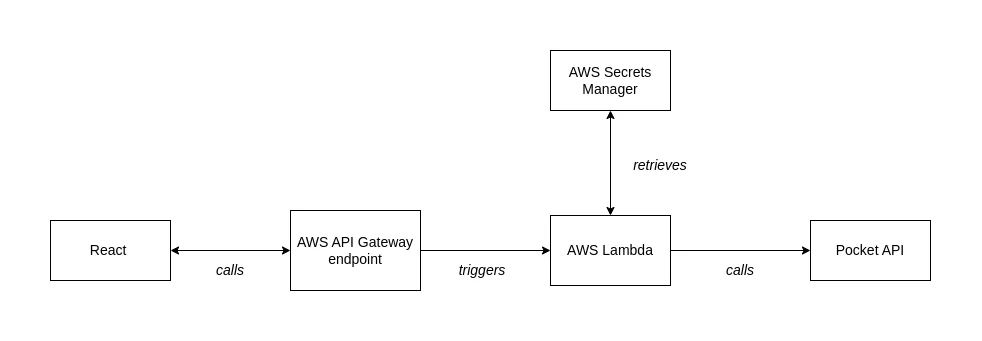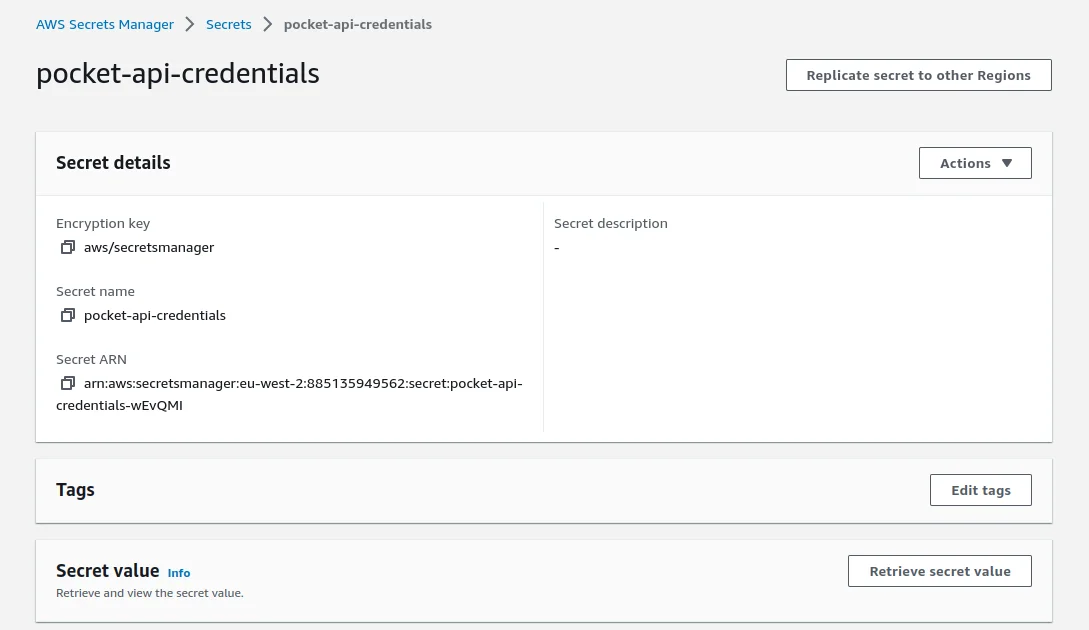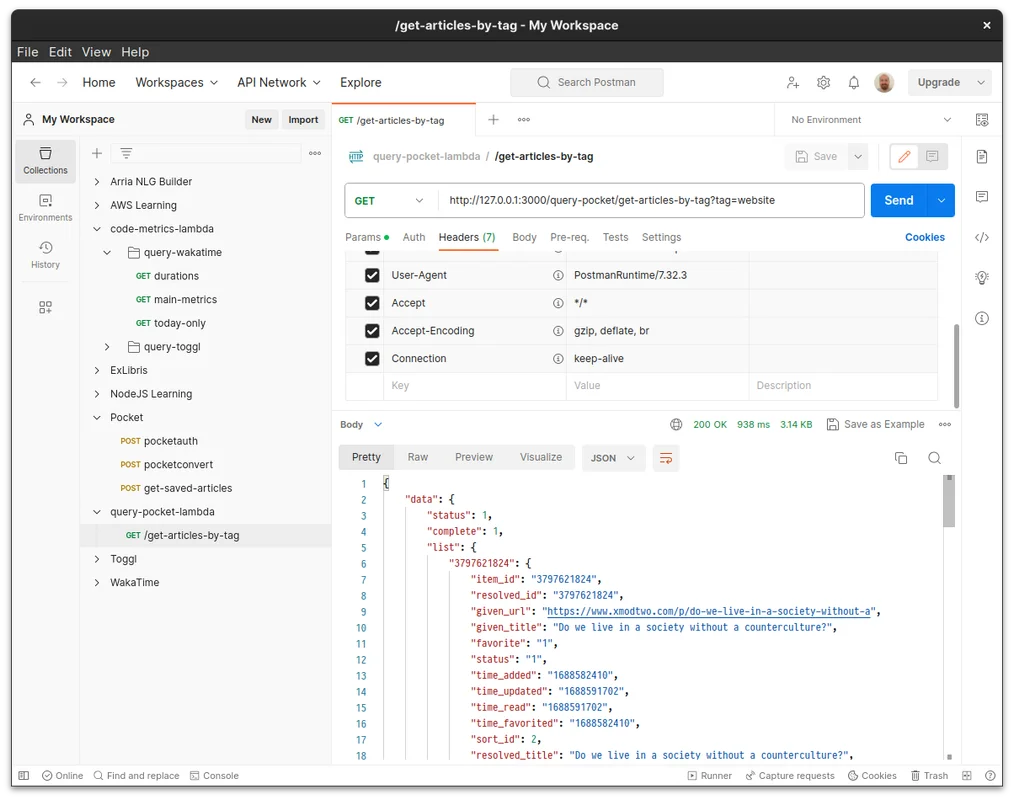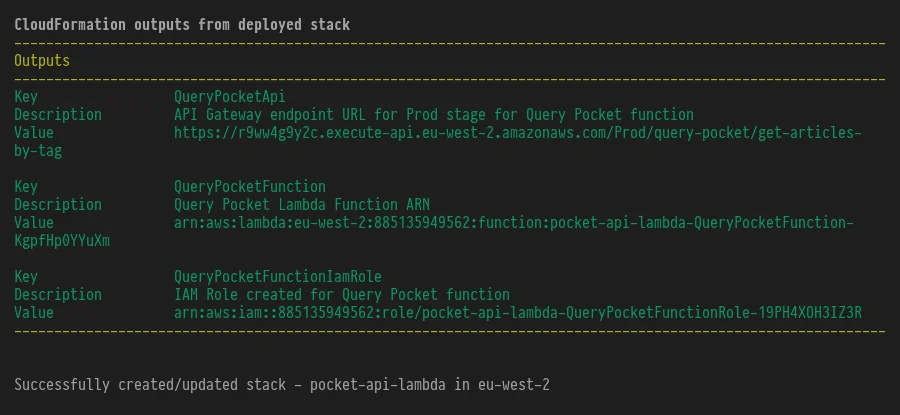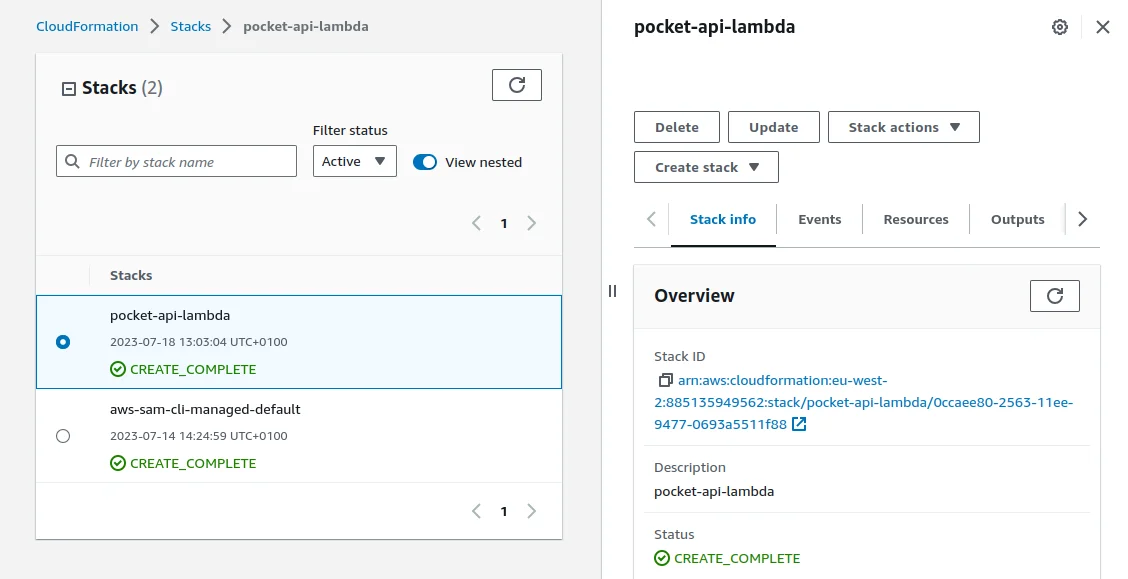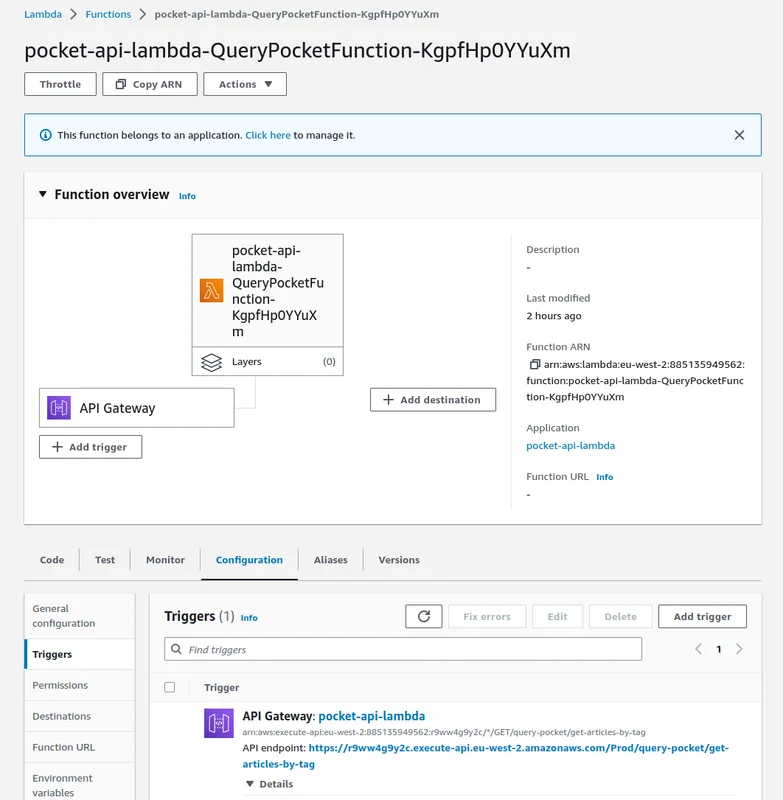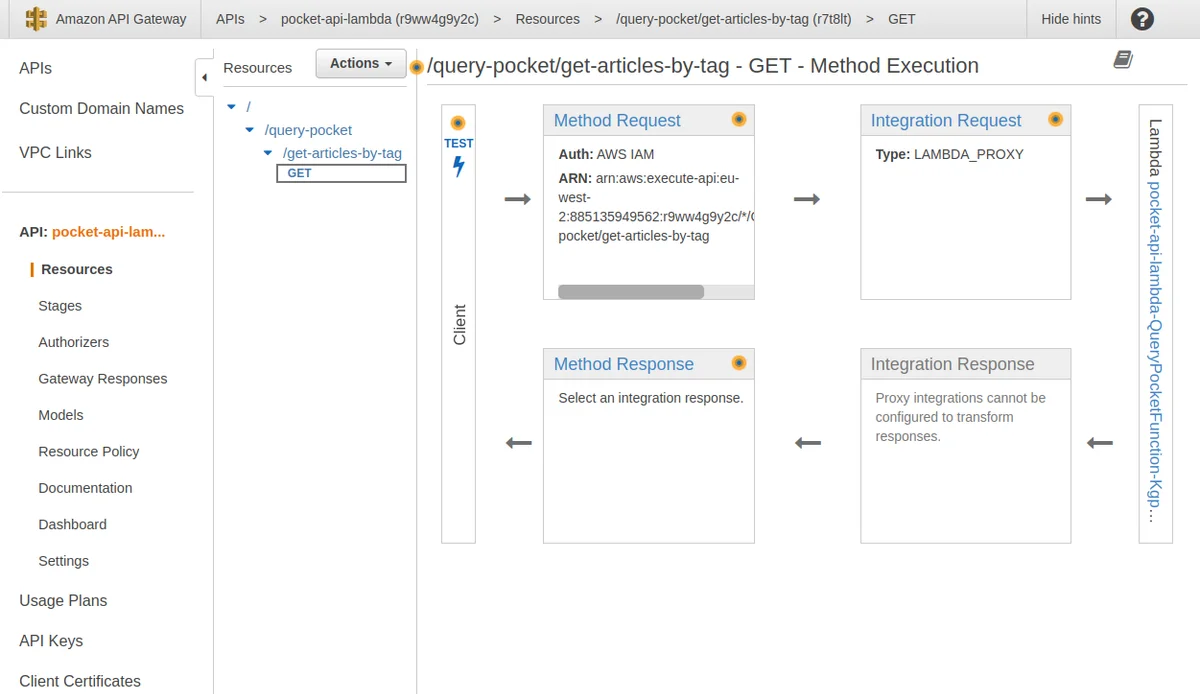22 KiB
| title | slug | date | tags | ||||
|---|---|---|---|---|---|---|---|
| AWS Lambda: recommended articles | /recommended-articles-integration | 2023-07-07 |
|
I've just added a new feature to the blog: a page that lists links to articles that I have found interesting. Here I will walk through the development process as it is a good example of setting up a simple AWS Lambda and will be useful for future reference.
Implementation
I use Pocket to manage my reading list. When I save an article that I want to
share to the blog I tag it with website. When querying the Pocket API I use
this tag to distinguish articles I wish to share from my other saves. I deploy a
Lambda function (written in TypeScript) that is accessible through an
AWS API Gateway
endpoint. This function simply sends a fetch request to the Pocket API and
returns the response via the Gateway endpoint.
The Lambda is just a wrapper around the API request - I am not storing any data in a database. Using a Lambda means that I can access my Pocket API credentials securely on the backend and also sidestep the issue of Pocket not allowing CORS requests from a frontend.
Backend
I will use the AWS Single Application Model (SAM) for development. This will allow me to develop and provision the Lambda locally and then deploy my specifications as a template to AWS via the terminal. Once deployed this template will be used by AWS CloudFormation to create a manage the resources I have specified. This simplifies and programatises much of the work involved in creating and running a serverless application on AWS, since you don't have to fiddle too much with different AWS services in the AWS web console.
Create Lambda template
I use the SAM CLI to bootstrap a NodeJS Lambda written in TypeScript:
sam init --runtime nodejs16.x
Update the defaults
This creates a basic hello world template that I will adapt for my project. I will also change the naming conventions and file structure as I dislike the defaults.
My directory stucture is as follows:
.
├── pocket-api-lambda/
│ └── src/
│ └── query-pocket/
│ ├── index.ts
│ ├── package.json
│ ├── tsconfig.json
│ └── tests/
└── template.yml
Create an IAM role for the Lambda function
Next I will provision for AWS to create a dedicated IAM role for my function. This is an executive role that will allow my function to access other services on my behalf. At deploy time, AWS will create the role and assign it an Amazon Resource Name (ARN). This is will uniquely identify the function's role within AWS.
Within the Resources object of the YAML template I add:
QueryPocketFunctionRole:
Type: AWS::IAM::Role
Properties:
AssumeRolePolicyDocument:
Version: "2012-10-17"
Statement:
- Effect: Allow
Principal:
Service:
- lambda.amazonaws.com
Action:
- "sts:AssumeRole"
Policies:
- PolicyName: lambda-execution-policy
PolicyDocument:
Version: "2012-10-17"
Statement:
- Effect: Allow
Action:
- "logs:CreateLogGroup"
- "logs:CreateLogStream"
- "logs:PutLogEvents"
Resource: "*"
This gives the function basic execution rights. I also need to add the IAM role
to the Outputs object in the template:
QueryPocketFunctionIamRole:
Description: "IAM Role created for Query Pocket function"
Value: !GetAtt QueryPocketFunctionRole.Arn
This is necessary for AWS to create a dedicated ARN for the function when the application is deployed.
Storing API credentials in AWS Secret Manager
In order to access the Pocket API you need to send HTTP POST requests to the endpoint with the following credentials supplied in the body:
{
"consumer_key": "[consumer_key_value_here]",
"access_token": "[access_token_value_here]"
}
Rather than hard code these credentials in my Lambda code, I will follow best practice and store them in AWS Secrets Manager which the Lambda will retrieve at runtime. This adds an extra layer of security and encrypts the credentials.
First I add the two values to Secrets Manager:
Then I add a resource permission to the existing Policies array for the
QueryPocketFunctionIamRole to allow the Lambda to access the secret,
specifying the ARN of the secret just created:
- PolicyName: secrets-manager-access
PolicyDocument:
Version: "2012-10-17"
Statement:
- Effect: Allow
Action:
- secretsmanager:GetSecretValue
Resource: arn:aws:secretsmanager:eu-west-2:[ACCOUNT_ID]:secret:[SECRET_REF]
I have put redacted private info by using square brackets: this isn't SAM syntax
Accessing credentials
Now that the function is permitted to access the given secret. I will write a function that will retrieve the credentials from Secrets Manager, which I can invoke from the Lambda:
const getPocketCredentials = async (): Promise<PocketCredentials> => {
const secretsManager = new AWS.SecretsManager()
const response = await secretsManager
.getSecretValue({ SecretId: process.env.SECRET_ARN as string })
.promise()
const secretValues = JSON.parse(response.SecretString as string)
if (secretValues) {
return {
accessToken: secretValues.POCKET_ACCESS_TOKEN,
consumerKey: secretValues.POCKET_CONSUMER_KEY,
}
} else {
throw new Error("Failed to return Pocket credentials")
}
}
type PocketCredentials = {
accessToken: string
consumerKey: string
}
This function invokes the SecretsManager module of the aws-sdk to retrieve
the secret and then exposes each key for destructuring within the main body of
the Lambda function. In order to do so, it needs access to the ARN for the given
secret which I have set as an environment variable in my template.yml:
...
Resources:
QueryPocketFunction:
...
Environment:
Variables:
SECRET_ARN:
arn:aws:secretsmanager:eu-west-2:[MY_ACCOUNT_ID]:secret:[MY_SECRET_ARN]
This is great for production but when I am working locally, I don't want to keep making requests to Secrets Manager as this is unnecessary and could become costly. Instead I will utilise environment variables for the different deployment context and reserve calls to Secrets Manager for when the Lambda is executing in production. When working locally, I will source the Pocket credentials from an env file.
First I create this file at env/local.env.json:
{
"QueryPocketFunction": {
"NODE_ENV": "development",
"POCKET_CREDENTIALS": "{\"POCKET_ACCESS_TOKEN\": \"[ACCESS_TOKEN_HERE]\",\"POCKET_CONSUMER_KEY\": \"[CONSUMER_KEY_VALUE_HERE]\"}"
}
}
This sets the Node runtime environment to development and ensures that the
POCKET_CREDENTIALS are sourced from this file rather than Secrets Manager. I
will add this file to the .gitignore so that it remains local. You'll notice
that even though this is JSON, I pass POCKET_CREDENTIALS as a string rather
than a nested object. This is because environment variables are a feature of the
operating system's shell and most OSs treat them as simple strings rather than
complex data structures.
Next I will update the Environment field in the template.yml so that it sets
the Node runtime to production when it is deployed. I will also add an empty
variable for POCKET_CREDENTIALS so that it can be set with the Secrets Manager
values in the production context.
...
Resources:
QueryPocketFunction:
...
Environment:
Variables:
SECRET_ARN:
arn:aws:secretsmanager:eu-west-2:[MY_ACCOUNT_ID]:secret:[MY_SECRET_ARN]
NODE_ENV: production
POCKET_CREDENTIALS: ""
Now I need to update the earlier getPocketCredentials function to distinguish
between deployment environments and source the credentials from each location
depending on the runtime:
const getPocketCredentials = async (): Promise<PocketCredentials> => {
if (process.env.NODE_ENV === "production") {
const secretsManager = new AWS.SecretsManager()
const response = await secretsManager
.getSecretValue({ SecretId: process.env.SECRET_ARN as string })
.promise()
const secretValues = JSON.parse(response.SecretString as string)
if (secretValues) {
return {
accessToken: secretValues.POCKET_ACCESS_TOKEN,
consumerKey: secretValues.POCKET_CONSUMER_KEY,
}
} else {
throw new Error("Failed to return Pocket credentials")
}
} else {
const localCredentials = JSON.parse(
process.env.POCKET_CREDENTIALS as string
)
if (localCredentials) {
return {
accessToken: localCredentials.POCKET_ACCESS_TOKEN,
consumerKey: localCredentials.POCKET_CONSUMER_KEY,
}
} else {
throw new Error("Failed to return Pocket credentials")
}
}
}
Now when I run sam build && sam local start-api it will run the production
version, sourcing the credentials from Secrets Manager. When I run the same
command but specify the local environment variables, it will bypass Secrets
Manager and get the credentials from the JSON file:
sam build && sam local start-api --env-vars /home/thomas/repos/lambdas/pocket-api-lambda/env/local.env.json
This command is a bit unwieldy to paste everytime, so I will write a Makefile that stores it:
.PHONY: clean build
clean:
rm -rf .aws-sam
build:
sam build
start-local:
make build && sam local start-api --env-vars /home/thomas/repos/lambdas/pocket-api-lambda/env/local.env.json
Now I can just run make start-local to get the local API endpoint up and
running.
Lambda handler function
Finally I will write the actual handler function:
export const handler = async (event: APIGatewayProxyEvent): Promise<APIGatewayProxyResult> => {
let response: APIGatewayProxyResult
const endpoint = `https://getpocket.com/v3/get`
try {
const { accessToken, consumerKey } = await getPocketCredentials()
const tag = event.queryStringParameters?.tag
const responseHeaders = {
"Content-Type": "application/json",
"Access-Control-Allow-Origin": "*",
}
const requestBody = {
consumer_key: consumerKey,
access_token: accessToken,
state: "all",
tag: tag,
}
const options: RequestInit = {
method: "POST",
headers: {
"Content-Type": "application/json; charset=UTF8",
},
body: JSON.stringify(requestBody),
}
const request: Response = await fetch(endpoint, options)
const requestJson: any = await request.json()
response = {
statusCode: 200,
headers: responseHeaders,
body: JSON.stringify({
data: requestJson,
}),
}
} catch (err: unknown) {
console.error(err)
response = {
statusCode: 500,
header: responseHeaders
body: JSON.stringify({
message: err instanceof Error ? err.message : "some error happened",
}),
}
}
return response
}
I'm sending a POST request to the Pocket API endpoint. If successful, I return
the data as the response, else I return an error code. You'll notice I am
retrieving queryStringParameter from the event object. This means I can pass
in different tags later, in case I want to retrieve different articles.
Locally, I would call the endpoint using the following URL:
http://127.0.0.1:3000/query-pocket/get-articles-by-tag?tag=website
The template file in full
Now the configuration is complete and the Lambda is written let's take a look at
the final template.yml:
AWSTemplateFormatVersion: "2010-09-09"
Transform: AWS::Serverless-2016-10-31
Description: >
pocket-api-lambda
Globals:
Function:
Timeout: 10
MemorySize: 256
Resources:
QueryPocketFunctionRole:
Type: AWS::IAM::Role
Properties:
AssumeRolePolicyDocument:
Version: "2012-10-17"
Statement:
- Effect: Allow
Principal:
Service:
- lambda.amazonaws.com
Action:
- "sts:AssumeRole"
Policies:
- PolicyName: lambda-execution-policy
PolicyDocument:
Version: "2012-10-17"
Statement:
- Effect: Allow
Action:
- "logs:CreateLogGroup"
- "logs:CreateLogStream"
- "logs:PutLogEvents"
Resource: "*"
- PolicyName: secrets-manager-access
PolicyDocument:
Version: "2012-10-17"
Statement:
- Effect: Allow
Action:
- secretsmanager:GetSecretValue
Resource: arn:aws:secretsmanager:eu-west-2:[ACCOUNT_ID]:secret:[SECRET_ID]
QueryPocketFunction:
Type: AWS::Serverless::Function
Properties:
CodeUri: src/query-pocket/
Role: !GetAtt QueryPocketFunctionRole.Arn
Handler: index.handler
Runtime: nodejs16.x
Architectures:
- x86_64
Events:
QueryPocketApi:
Type: Api
Properties:
Path: /query-pocket/get-articles-by-tag
Method: get
Environment:
Variables:
SECRET_ARN: arn:aws:secretsmanager:eu-west-2:[ACCOUNT_ID]:secret:[SECRET_ID]
NODE_ENV: production
POCKET_CREDENTIALS: ""
Metadata:
BuildMethod: esbuild
BuildProperties:
Minify: true
Target: "es2020"
Sourcemap: true
EntryPoints:
- index.ts
Outputs:
QueryPocketApi:
Description:
"API Gateway endpoint URL for Prod stage for Query Pocket function"
Value: !Sub "https://${ServerlessRestApi}.execute-api.${AWS::Region}.amazonaws.com/Prod/query-pocket/get-articles-by-tag"
QueryPocketFunction:
Description: "Query Pocket Lambda Function ARN"
Value: !GetAtt QueryPocketFunction.Arn
QueryPocketFunctionIamRole:
Description: "IAM Role created for Query Pocket function"
Value: !GetAtt QueryPocketFunctionRole.Arn
To summarise, and cover the parts of the template I have not already explained:
-
I am creating provisions for three entities:
- A Lambda function
- An API Gateway enpoint that will trigger the function
- An IAM role for the Lambda function
-
In addition I am setting permissions so that my Lambda function can access a value stored in Secrets Manager, along with associated environment variables.
-
I have a single endpoint:
/query-pocket/get-articles-by-tag. I have given it it's own path rather than just using the root/query-pocketbecause I may add additional endpoints in the future -
My Lambda function is defined in
/query-pocket/index.ts
Now when I start the server locally and call the endpoint from Postman I can see the data returned:
Deploying the function
I start by validating my template to ensure that I do not introduce problems at the outset of the deployment:
sam validate
/home/thomas/repos/lambdas/pocket-api-lambda/template.yaml is a valid SAM Template
Then I run a build:
sam build
Next I package the application. CloudFront can only receive one file as an input. When we package the application we create this single file. The packaging proces will first archive all of the project artefacts into a zip file and then upload that to an AWS S3 bucket. A reference to this S3 entity is then provided to CloudFormation and used to retrieve the requisite artefacts.
sam package
--template-file template.yaml
--output-template-file pkg.yaml
--region eu-west-2
This outputs the following, confirming the creation of the zipped resources:
Managed S3 bucket: aws-sam-cli-managed-default-samclisourcebucket-xc8swn6xu4km
A different default S3 bucket can be set in samconfig.toml
Or by specifying --s3-bucket explicitly.
Uploading to 67c241b6f81524ee092adab3ba9998c5 50691677 / 50691677 (100.00%)
Successfully packaged artifacts and wrote output template to file pkg.yaml.
Execute the following command to deploy the packaged template
sam deploy --template-file /home/thomas/repos/lambdas/pocket-api-lambda/pkg.yaml --stack-name <YOUR STACK NAME>
Now that we have our packaged application, the last step is to deploy it:
sam deploy --guided
This presents me with options for the deployment defaults. The most important
one is Allow SAM CLI IAM role creation. By affirming this, AWS will create the
QueryPocketFunctionIamRole and generate an ARN for it.
This takes a few minutes but the CLI will keep you up to date with the deployment process. Then, if successful, it will confirm the resources it has created:
If I go to CloudFormation in the AWS I will see that the pocket-api-lambda
stack now exists:
And a new function is added to AWS Lambda with the API Gateway endpoint as the trigger:
And in API Gateway the API has also been set up:
Frontend
My frontend is built with the GatsbyJS library and so is React-based.
Environment variables
Early I took to trouble to run both development and production versions of the API. When I am working locally on my site I want to be querying the local endpoint rather than the production version since this will accrue fees and also requires me to deploy after every change.
I will use an environment variable to distinguish the local and production endpoints. I do this using the dotenv Node package and create the following two files:
# .env.production
GATSBY_POCKET_AWS_LAMBDA_ENDPOINT=https://[HASH].execute-api.eu-west-2.amazonaws.com/Prod/query-pocket/get-articles-by-tag
# .env.development
GATSBY_POCKET_AWS_LAMBDA_ENDPOINT=http://127.0.0.1:3000/query-pocket/get-articles-by-tag
By prepending the variable name with GATSBY, Gatsby will know to inject these
values at runtime. This way, and by adding my .env files to the .gitignore,
I can avoid hardcoding my endpoints and can use a single reference in my React
component.
When working locally I can run NODE_ENV=development npm run start to source
the local endpoint variable and NODE_ENV=production npm run start to source
the production endpoint variable. In the deployed production context however,
.env.production will not be available because it is an ignored file. Thus to
source the variables when npm run build is run remotely, it is necessary to
store them as secrets that can be accessed in my CI/CD pipeline. I use a
GitHub Action to build my
site and deploy it to AWS when I push changes, so I add the following line to my
main.file build script:
steps:
- name: Set environment variables
run: |
echo "GATSBY_POCKET_AWS_LAMBDA_ENDPOINT=${{ secrets.GATSBY_POCKET_AWS_LAMBDA_ENDPOINT }}" >> $GITHUB_ENV
echo "GATSBY_METRICS_AWS_LAMBDA_ENDPOINT=${{ secrets.GATSBY_METRICS_AWS_LAMBDA_ENDPOINT }}" >> $GITHUB_ENV
React component
Below is the React component:
const ENDPOINT = process.env.GATSBY_POCKET_AWS_LAMBDA_ENDPOINT
const ArticleListing = ({ article }) => {
return (
<tr>
<td>
<a href={article?.resolved_url} target="_blank">
{article?.resolved_title}
</a>
</td>
<td>{formatUnixTimestamp(article?.time_added)}</td>
</tr>
)
}
export default function RecommendedArticlesPage() {
const [loading, setLoading] = useState(false)
const [data, setData] = useState({})
useEffect(() => {
const fetchData = async () => {
try {
setLoading(true)
const response = await axios.get(`${ENDPOINT}?tag=website`)
setData(response?.data?.data?.list)
} catch (error) {
console.error(error)
} finally {
setLoading(false)
}
}
fetchData()
}, [])
const articles = Object.keys(data).map((key) => data[key])
return (
<Main>
<PageHeader headerTitle="Recommended articles" />
<p>
Articles written by others that I have learned from or which present
interesting viewpoints.
</p>
<table className="articles-table">
<thead className={loading ? "loading" : ""}>
<tr>
<th>Title</th>
<th>Date added</th>
</tr>
</thead>
<tbody>
{articles?.map((article) => (
<ArticleListing key={article?.item_id} article={article} />
))}
</tbody>
</table>
</Main>
)
}
Here I source my environment variable from the Node runtime context and use it
to query the API via the React useEffect hook that runs once on load. Then I
loop through the data to populate the rows of an HTML table.
Addendum: authentication
I have set up a basic AWS Gateway API with two execution contexts (local and production) that trigger a Lambda function. In closing I want to note that a considerable oversight is the lack of authentication for the remote endpoint. In its current state anyone with access to the production URL can call the API.
In this context it's not that big of a deal since the information is not sensitive or particularly interesting however if I was following best practice I would need to provide a way for AWS to authenticate requests. I did attempt this using an IAM role and an AWS Cognito user pool however I was unable to get this working despite my best efforts. This is something I will return to in a future post.
